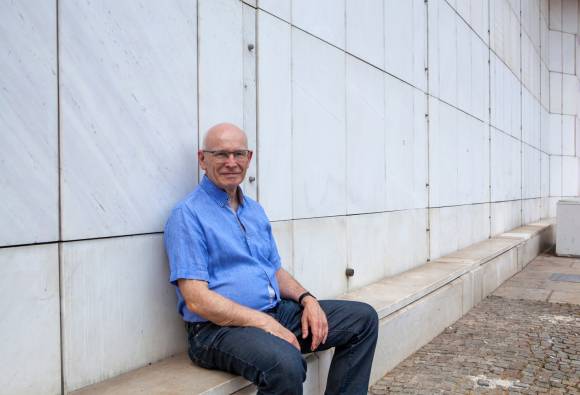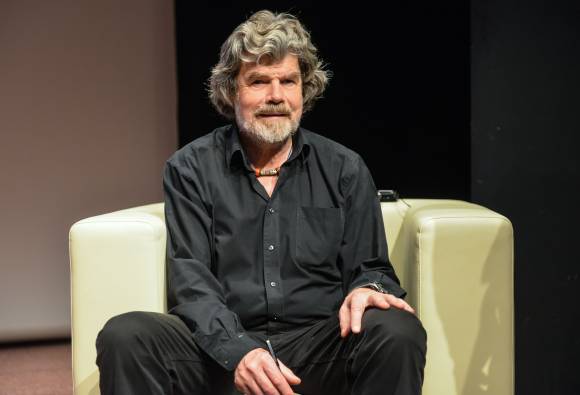World premiere of the Last Expedition Festival
The great mountaineer’s final visit to Slovenia

The Master/s
The Master/s: On the Contemporary Structures of Power
Conference; the main event of the Humanities Programme
New Figures of the Master in Today’s World
The question of the Master stretches back to times immemorial, to the very origins of human culture, and since the outset it has kept haunting our history throughout millennia, presenting ever new facets and enigmas. Why and how would someone acquire the superior status of a leader, a person in charge and in command, with the inscrutable aura of a Master, wielding the imperious power over people? And why would the others submit and accept the exceptional authority of the Master, comply with his commands, and acquiesce in their compliance?
The question is of course at the core of all political philosophy and more widely of a vast variety of reflections on the foundations of social domination, be it in the attempts to legitimize the power of some people over the others, be it in the attempts to put an end to it. The conference organized at Cankarjev dom doesn’t aim at addressing the vastness of these intricate questions, all of them with a very long and venerable history, but to engage with the problem of the present-day figures of the Master, to see in what ways these figures present a novelty in relation to tradition, recent and old, and what can be done to invent strategies to counteract them.
The French revolution can serve as a shorthand for the inauguration of modernity and hence a handy watershed (albeit problematic) in conceiving the figure of the Master. On the one side of the divide, in pre-modern times, the position of the Master was based on a certain conception of sovereignty, on transcendence, on hereditary entitlement, on descent, on the supposedly natural hierarchies, on paternal authority – the authority of the father so often serving as the model of all authority. On the other side of the divide, with the triumphant ideas of the enlightenment, one has allegedly done away with all these grounds for domination, one has entered an era where authority should be based on capacities, knowledge, expertise, competence, efficiency, abilities, free competition, use of reason and the progress of science. In one word, modernity was supposed to bring about the death of the Master, with capital M. By the time we entered the 20th century it became clear that this optimistic scenario was but a mirage. The century has seen carnages, worse than any in history, under the auspices of new kinds of Masters, whose authority may be reminiscent of the pre-modern type of authorities, but whose logic was essentially different. The master figures loomed large, with the twin calamities of fascism and Stalinism, and apart from that with a variety of other dictatorships. The figure of the Master was back, with a vengeance, as if it had been granted a new afterlife.
The focus of the conference are the present times, the times after the alleged end of history, with the prospect of market economy and liberal democracy defining the horizon of global progress and prosperity. So why is it that we are facing the resurgence of new figures of masters? Why is it that the growth of populism in the last decade and more started to largely define our political horizon and our agendas? The particular figures may seem to owe their rise to the contingencies of particular constellations but taken together they form a new pattern which causes grave concerns and calls for serious reflection.
The new types of masters (nomina sunt odiosa) don’t quite fall into the same category, but there are some prominent features that one can discern. Far from being the awesome Master figures endowed with aura and charisma, they rather look like caricatures of master figures, fake masters often labelled as clowns and buffoons, subject to numerous but impotent parodies. They are often described as the figures of obscenity of power – power always had an obscene underside that it tried to keep hidden, but the new element is that the obscene underside now tends to freely come to the fore, without it having any serious consequences. It even appears that a reverse logic is taking place, namely that the more the obscene comes to the fore, the more it enhances the new master figures. They are immune to being disclosed as liars and unfit for public office, the revelations which would have destroyed anyone a decade ago now function as a boost. The master turning out to be a fake doesn’t undermine his position but contributes to its status. Moreover, the particular appeal of these figures also pertains to the fact that they constantly break all the unwritten rules, the thin and tenuous line between what was commonly accepted as decent or ruled out as indecent. But the unwritten rules, although elusive and hard to define, form the fabric of social life, and when the completely unacceptable starts to be gradually accepted and accommodated, then the very texture of our social bonds is put into jeopardy. The fact that they most often appear as figures of transgression poses questions about the new avatars of sovereignty and political legitimacy.
The figure of the Master thus presents the red thread of the conference. Its focus is the present predicament, but in order to address it one has to bring in a number of different approaches, perspectives, conceptual and artistic tools, addressing also tradition and history. One cannot engage with these new figures of the master without considering tradition and history, without introducing reflections on the nature of domination in its vast varieties and on its origins. The project brings together a variety of scholarship from different fields, political theory, philosophy, psychoanalysis, gender studies, postcolonial studies, cultural studies, etc.
New interventions in classical texts from Plato to Hegel's Master-Slave dialectic are encouraged. A special reflection is dedicated to new (self-)presentations of the authorities projected via mass media and social media and which differ greatly from both the presentations of traditional masters and totalitarian leaders. The shifts in the current structure of capitalism are touched upon, the developments for which new terms are being coined, including "techno feudalism," "surveillance capitalism," "platform capitalism," "big data", etc. And, as much as the traditional figure of the master was grounded in the authority of the father, further consideration is given to the decline of classical authority and the ways in which the changes in sexuality and sexual roles pertain to contemporary forms of masterdom.
With a host of prominent national and foreign scholars contributing to the conference, we can look forward to an important intellectual event.
Dr. Mladen Dolar
22.9.2022 I THURSDAY
11:00-12:00 Andrew Cole
12:00-13:00 Jure Simoniti
13:00-15:00 lunch break
15:00-16:00 Aaron Schuster
16:00-17:00 Bara Kolenc
17:00-18:00 Peter Klepec
18:00-19:00 break
19:00-20:00 Slavoj Žižek
23.9.2022 I FRIDAY
11:00-12:00 Mladen Dolar
12:00-13:00 Jamila Mascat
13:00-15:00 lunch break
15:00-16:00 Simon Hajdini
16:00-17:00 Henrik Joker Bjerre
17:00-18:00 break
18:00-19:00 Yuval Kremnitzer
19:00-20:00 Frauke Berndt
24.9.2022 I SATURDAY
11:00-12:00 Frances Restuccia
12:00-13:00 Goran Vranešević
13:00-15:00 lunch break
15:00-16:00 Gregor Moder
16:00-17:00 Arthur Bradley
17:00-18:00 break
18:00-19:00 Anca Parvulescu
19:00-20:00 Eric Santner
All events in Kosovel hall, except 22 September at 7 pm in Linhart hall


 Reinhold Messner at Cankarjev dom
" width="580" height="395">
Reinhold Messner at Cankarjev dom
" width="580" height="395">

